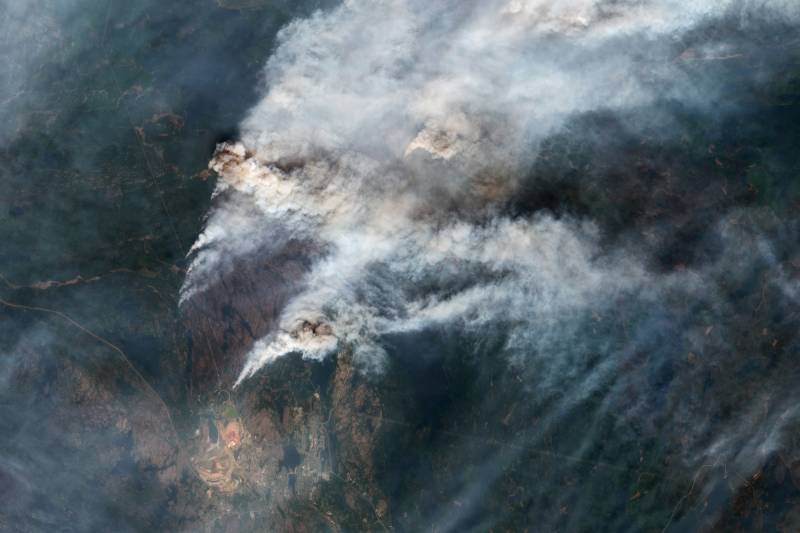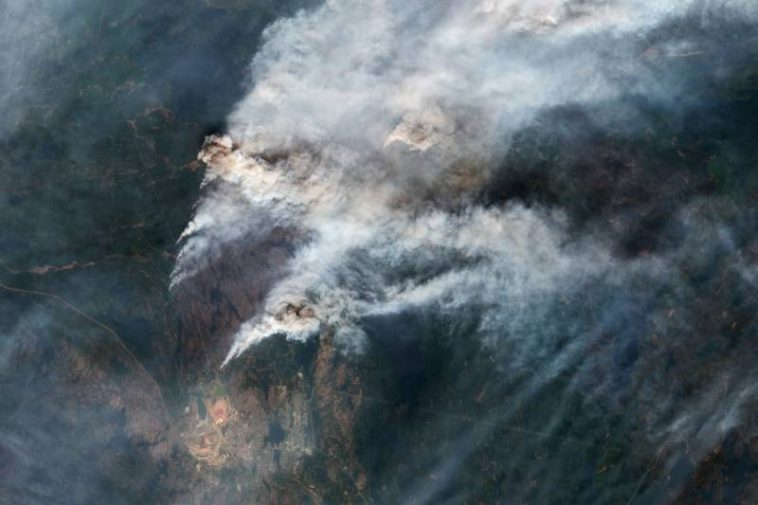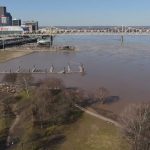
The Wildfire Smoke Dilemma: A Closer Look at Cross-Border Challenges
The recurrent issue of wildfire smoke over Michigan’s idyllic landscapes has emerged as a major point of contention between American lawmakers and their Canadian counterparts. Recently, seven Michigan Republican members of the state’s congressional delegation have called for decisive measures by Canada to contain wildfires that have been degrading air quality across Michigan. This opinion piece takes a closer look at the tangled issues behind the wildfire smoke phenomenon, the effects on Michigan’s summer leisure experiences, and the potential implications for U.S.-Canada relations.
What makes this situation particularly nerve-racking is how every summer, families looking forward to enjoying Michigan’s beautiful lakes and campgrounds are instead forced to contend with unhealthy air laden with particulate matter. The wildfire smoke has been described as a recurring threat that now looks set to be a feature of Michigan summers, impacting public health in ways that touch every community member, especially those with pre-existing respiratory conditions.
Understanding the Air Quality Crisis and Its Impact on Summer Vacations
Michigan’s summers have always been a time when people escape the urban sprawl to enjoy outdoor adventures. However, in recent years, the air quality has suffered due to smoke from Canadian wildfires. Billions in potential losses from tourism have been predicted as the air turns hazardous for vulnerable groups such as seniors, pregnant women, and children. With millions under air quality alerts – a staggering figure that, according to one representative, exceeds even the population of Canada – the issue has quickly escalated from a localized environmental concern to a broader public health crisis.
How Hazardous Air Quality is Altering Vacation Plans
The change in the quality of air during peak vacation seasons is not just an environmental statistic—it is a matter of everyday life for Michiganders. Families who once enjoyed serene nights under starry skies at pristine campgrounds are now exposed to air that could worsen respiratory problems. The following bullet list summarizes some of the key problems faced by residents:
- Increased health problems among those with pre-existing conditions
- Frequent alerts leading to cancellations of outdoor events
- Economic implications for local tourism industries reliant on clean air
- Heightened anxiety and stress among parents planning family vacations
Atmospheric experts from the Michigan Department of Environment, Great Lakes and Energy have warned that the smoky haze might not only endanger sensitive groups but could also pose risks to the general population during peak periods. The threat becomes even more palpable when considering the long-term impacts of breathing poor-quality air.
The Economic and Social Impact on Michigan Communities
In the state of Michigan, outdoor recreation is more than a leisure activity—it is a cornerstone of local culture and economy. The fine details of how wildfire smoke affects tourism, small businesses, and community health are worth a closer look:
-
Tourism Revenue Loss:
Many local businesses rely on healthy summer tourism. As wildfire smoke becomes more common, tourists are discouraged from visiting popular destinations, affecting revenue. -
Healthcare Burden:
With a rise in respiratory issues, the local healthcare system may face increased pressure, translating into higher costs and the need for more public health interventions. -
Community Stress:
Longstanding residents face stress and anxiety as each summer brings the nerve-racking prospect of poor air quality interfering with long-awaited outdoor family events.
These points not only illustrate the immediate impacts but also raise the need for longer-term strategies to safeguard Michigan’s outdoor lifestyle. With each passing summer, the community is forced to adapt to a new normal where outdoor enjoyment may come with potential health risks.
Considering the Climate Change Element and Its Role in Wildfire Occurrence
To truly grasp the state of things, one must take a closer look at the environmental underpinnings of the crisis. Climate change has been identified as a super important factor that is fueling Canadian wildfires. Rising global temperatures, linked to the elevated levels of greenhouse gases, are causing drier conditions in regions that are already prone to drought. This creates the perfect recipe for wildfires that are both intense and far-reaching.
Digging into the Scientific Backdrop: How Climate Change Fuels Wildfires
Experts are increasingly vocal about the relationship between a warming planet and the frequency of wildfires. Some important scientific insights to keep in mind include:
-
Increased Atmospheric Moisture:
As temperatures rise, the atmosphere is capable of holding more moisture, leading to extreme rainstorms followed by prolonged periods of drought—conditions conducive to wildfires. -
Drier Vegetation:
With persistent drought conditions in the areas where Canadian wildfires are ramping up, the vegetation becomes dry and highly combustible. -
Synergistic Effects:
Climate change’s role in pushing both intense droughts and torrential rains creates the perfect volatile mix for the ignition of wildfires.
The argument presented by experts like Jonathan Overpeck of the University of Michigan stresses that the current measures in place to battle wildfire occurrences might not be sufficient in this new, warming world. Overpeck notes that while it may be challenging for any nation to completely prevent fires, it is both logical and reasonable to expect that all countries, including Canada, take more assertive action in managing situations that have cross-border effects.
Climate Change Policies on Both Sides of the Border
Interestingly, while Michigan GOP lawmakers are placing the blame on Canada for the wildfires, there is growing frustration on both sides of the border regarding existing climate change policies. U.S. policy shifts under certain administrations have reduced the scope of measures aimed at reducing greenhouse gas emissions, making the air quality issues even more pressing. On the Canadian side, local leaders have expressed concerns about oversimplifying the wildfire crisis without acknowledging the larger issue of climate change.
A table below highlights the interconnected factors between climate change, wildfire incidences, and air quality challenges:
| Factor | Impact on Wildfires | Impact on Air Quality |
|---|---|---|
| Rising Temperatures | Increased evaporation and dryness | Enhanced susceptivity to smoke dispersion |
| Prolonged Droughts | Dry, brittle vegetation ready to burn | Larger areas affected by smoke |
| Intense Rainstorms | Temporary relief but long-term risks remain | Fluctuations in pollution levels |
| Policy Shifts | Reduced funding for fire-prevention strategies | Weakened air quality protections |
These elements paint a complicated picture of how intertwined policy, environment, and public health have become due to the changing climate. It’s a tangled web where solving one problem often requires addressing several other related challenges.
America’s Response and the Political Overtones
Even as scientific communities and healthcare practitioners emphasize the need for robust climate action, some U.S. lawmakers are quick to point fingers. The seven Michigan GOP representatives have held Canada directly responsible for the continued deterioration of air quality. Their public statement accuses Canada of not taking satisfactory action to prevent and control wildfires, and by extension, of neglecting measures that could safeguard Michigan’s residents from the harmful effects of smoke.
Political Statements and the Broader Diplomatic Fallout
The political rhetoric in this matter has intensified the debate. For instance, Representative John James from Shelby Township, who is also running for governor, has been particularly vocal. According to his assertions, the situation has reached a scale that “actively damages the U.S.-Canada relationship.” Critics, however, argue that such statements are an oversimplification of a full of problems scenario that has its roots in climate change and shared environmental responsibilities.
Key points raised by the lawmakers include:
- The frustration of constituents who are tired of enduring what is seen as a predictable, recurring air quality issue.
- The assertion that Canada must “take immediate and decisive action” to control the fires that jeopardize public health.
- The concern that poor air quality is not just an inconvenience but a significant threat that demands urgent attention from all responsible parties.
While it is understandable that voters expect clear answers and decisive action, the political debate has often obscured the underlying, nerve-racking details of the environmental crisis. The exchange of blame between U.S. legislators and Canadian officials only serves to distract from the essential need for a cooperative and comprehensive strategy to manage both wildfires and climate change impacts.
The Cross-Border Dynamic: Shared Responsibilities and Challenges
The border between the United States and Canada has historically been a place of mutual respect and cooperation. However, the current wildfire crisis has added a layer of tension to this long-standing relationship. The dialogue now extends beyond traditional policy disputes to include critical environmental issues that affect both nations.
Finding a Path Forward: Cooperative Measures and Bilateral Solutions
One of the positive signs in this scenario is the growing recognition that no single country can tackle these challenges alone. The cross-border nature of the wildfires means that effective solutions require collaborative efforts between the two nations. This entails looking beyond political blame games and focusing on shared objectives:
-
Joint Fire Management:
Both countries could benefit from enhanced cooperation in wildfire prevention and management. This might include shared resources, coordinated early-warning systems, and joint firefighting strategies. -
Climate Change Mitigation:
Addressing the root cause is essential. Collaborative efforts to reduce greenhouse gas emissions could lead to a reduction in the extreme weather patterns that precipitate wildfires. -
Investment in Research:
United research initiatives aimed at understanding local weather patterns, soil conditions, and the behavior of wildfires can help tailor strategies to the micro-level challenges each region faces.
These suggestions align with what many experts have been advocating for some time. While the political debate continues to be loaded with issues, those on the ground are more interested in straightforward, tangible measures that can protect lives and livelihoods.
Enhanced Communication and Scientific Collaboration
Another key aspect of overcoming these challenges lies in dedicated scientific collaboration. Researchers on both sides of the border need to work together to track the subtle details of wildfire behavior. Initiatives such as shared satellite monitoring systems and joint analyses of weather data can make a significant difference in how quickly and effectively each nation can respond to wildfire outbreaks.
By fostering a truly bilateral approach to emergency management, both the United States and Canada could not only minimize immediate health risks but also strengthen the diplomatic ties that have long been a hallmark of their relationship. A coordinated response in situations like these serves the dual purpose of protecting public health and reinforcing international cooperation.
Charting a Cooperative Future for Environmental Safety
The ongoing public health crisis—exemplified by persistent air quality alerts and the resulting challenges for local tourism—underscores an urgent need for joint efforts in wildfire management and climate change mitigation. Even though political leaders are quick to pinpoint blame, reality reveals a scenario filled with tricky parts that span across national borders and policy spheres.
The broader goal now should be to create a collaborative framework that addresses both the immediate dangers of wildfire smoke and the extensive, underlying climate issues. Such a framework might encompass:
-
Robust Emergency Response Programs:
Establishing rapid-response teams and cross-border protocols for wildfire incidents. -
Long-Term Climate Initiatives:
Joint strategies to reduce fossil fuel dependency and promote renewable energy sources that help curb ignition risks. -
Community Engagement:
Educating the public about how to protect themselves from poor air quality and what measures are being taken to tackle the wildfire and climate challenges.
Many experts insist that while it is off-putting to face a scenario where every summer raises alarm bells about polluted air, it could be transformed into an opportunity for international partnership. By working together, the nations can make significant strides in battling global warming and its local consequences.
Breaking Down Barriers: The Need for Transparent Communication
Transparency is key when dealing with issues that are as widespread and nerve-racking as wildfire smoke. Both governments must engage with the communities they serve and provide straightforward, actionable information about what measures are being implemented and the expected timelines for those efforts. In doing so, they not only help mitigate the health risks but also reduce the mounting tension caused by uncertainty and political rhetoric.
For instance, the Michigan representatives’ call on the Canadian government is a politically charged appeal. Yet, in practical terms, it is really about ensuring that firefighting resources, advanced warning systems, and international collaboration are all aligned in such a way that the next outbreak of wildfire-induced smoke is met with a proactive, rather than reactive, response. Both nations can learn from each other’s successes and shortcomings based on documented data, community feedback, and environmental research.
A detailed plan involving regular bilateral meetings, joint simulation exercises, and a shared repository of wildfire risk assessments could help both countries better predict and manage the spread of harmful smoke. By taking a step back and adopting a cooperative mindset, policymakers can figure a path toward a future where such nerve-racking challenges are mitigated through scientific inquiry and coordinated action.
Public Health at Stake: A Call for Empathy and Effective Action
At the heart of the controversy over wildfire smoke lies the everyday reality of citizens whose health and everyday lives are directly impacted. For the average Michigander, the lens through which policymakers view the crisis must shift from political rhetoric to empathetic action that prioritizes well-being.
Protecting the Vulnerable Amid Environmental Challenges
Public health experts agree that certain segments of the population are more susceptible to the adverse effects of poor air quality. The following list outlines some of the groups most at risk:
- Seniors: Older individuals may have existing respiratory or cardiovascular conditions that are exacerbated by smoky air.
- Children: Young lungs are especially sensitive to particulate matter, leading to potential long-term health complications.
- Pregnant Women: Exposure to polluted air can risk complications during pregnancy.
- People with Pre-Existing Conditions: Individuals suffering from asthma, COPD, or other respiratory issues are in immediate danger when air quality dips.
It is essential for government agencies, hospitals, and community organizations to work together in educating the public about the steps they can take to minimize these risks. Recommendations often include staying indoors when smoke levels are high, using air purifiers, and wearing masks to filter out particulate matter when venturing outside.
Community Outreach and Preparedness Programs
Effective community response strategies serve as the backbone of a resilient public health system. Some of the measures that local governments can consider are:
- Temporary Shelter Improvements: Setting up well-ventilated community centers where people can seek respite during periods of poor air quality.
- Mobile Health Clinics: Bringing health services to neighborhoods most affected by smoke alerts can help manage any immediate respiratory issues.
- Public Awareness Campaigns: Informing residents about local air quality indices and emergency measures through regular broadcasts, social media updates, and community meetings.
When communities are made aware of the risks and equipped with practical safety measures, the overall impact of wildfire smoke on public health can be markedly reduced. These initiatives should be viewed as critical investments that not only protect lives but also foster a sense of solidarity during challenging times.
Toward a Sustainable Future: Balancing Environmental Protection and Economic Growth
While wildfire management and climate change mitigation are top priorities for public health and environmental safety, the broader picture encompasses economic stability and community well-being. Michigan’s vibrant outdoor recreation industry is a primary source of both local pride and economic prosperity, and protecting it requires a balanced approach that considers environmental, health, and fiscal factors.
Strategies for Sustainable Tourism Amid Environmental Challenges
With the summer season being a key driver of local tourism, it is super important to implement forward-thinking strategies to ensure that Michigan’s lakes, campgrounds, and natural attractions continue to be safe and appealing. Some of the strategies that could be explored include:
- Improved Monitoring Systems: Leveraging technology such as drones and satellite imagery to monitor air quality in real time can help authorities issue timely alerts and adjust visitor recommendations.
- Enhanced Infrastructure: Investing in improved community infrastructure, such as better ventilation in public shelters and advanced air purification systems in recreation centers, ensures that visitors and residents have safe alternatives during episodes of poor air quality.
- Collaborative Economic Policies: Forming economic partnerships between local governments, tourism boards, and environmental agencies can facilitate the mobilization of resources to address the impact of wildfire smoke.
Creating a robust framework around these key points not only secures the future of Michigan’s tourism sector but also sets a precedent for other regions grappling with similar challenges. Striking a balance between economic growth and environmental sustainability is one of the little details that national leaders must figure a path toward in the coming years.
The Role of Local Businesses and Tourism Boards
It is important not to understate the role of local initiatives in managing these challenges. Small businesses and tourism boards have been on the front lines, often adapting quickly to changing circumstances by adjusting operating hours, offering alternative indoor attractions, or even partnering with environmental advocacy groups to disseminate vital information. In many cases, local leadership has filled gaps left by national policies, providing a model for proactive, community-based responses.
A summary of promising practices includes:
- Promoting indoor attractions during periods of high smoke exposure.
- Collaborating on public health campaigns to raise awareness about air quality standards.
- Leveraging local media for real-time updates and safety guidelines.
These practices highlight how communities, when working together, can adapt to even the most overwhelming situations. The cooperation between state officials, local business owners, and community organizations serves as an encouraging example of resilience in the face of recurring environmental challenges.
Conclusion: A Call for Pragmatic Partnership and Comprehensive Policies
The wildfire smoke issue in Michigan is a textbook example of how environmental challenges do not respect international borders. While the seven Michigan Republican lawmakers have demands for Canada to act decisively, the bigger picture involves an array of tricky parts—ranging from climate change and public health to economic impacts and diplomatic relations—that must be addressed in unison. The repeated exposure to hazardous air is a stark reminder of the need for comprehensive strategies that blend scientific insights, robust health policies, and cooperative international dialogue.
At the core, this is a public health emergency that demands mutual responsibility. Both the United States and Canada have a shared role in finding your way through the twists and turns of climate change, wildfire management, and environmental protection. Instead of pointing fingers, the focus should shift to crafting strategies that help communities thrive while safeguarding nature’s delicate balance.
In a world where the effects of global warming ripple across borders, it is critical to ensure that all nations remain engaged in constructive dialogue and proactive solutions. Whether it is through joint research initiatives, better emergency preparedness programs, or adaptive tourism strategies, the path forward is undeniably a collective one. Public safety, economic stability, and environmental integrity are all interlinked and must be approached as part of a larger, coordinated effort.
Michigan’s experience is a wake-up call not only for regional policymakers but for decision-makers across North America and beyond. By taking a holistic view that emphasizes collaboration over confrontation, communities can transform these nerve-racking challenges into opportunities for enduring change. The goal is clear: to ensure that every family looking forward to a summer getaway can once again enjoy clear skies, fresh air, and the wonder of nature without compromise.
Ultimately, the way forward involves a blend of immediate tactical actions to protect residents during wildfire episodes and long-term strategies to address the underlying climate issues. This balanced and comprehensive approach will lessen the nerve-racking impact of wildfire smoke, foster stronger international partnerships, and help forge a future where environmental health is viewed as a shared, cross-border responsibility.
As both local and national leaders reexamine their roles in mitigating these challenges, an open dialogue rooted in scientific research, mutual respect, and genuine cooperation will be the bedrock upon which lasting solutions are built. Through collective action and pragmatic partnerships, the twin goals of safeguarding public health and ensuring economic prosperity can be reconciled, offering hope for a sustainable future for everyone.
Originally Post From https://www.detroitnews.com/story/news/politics/2025/08/06/michigan-republicans-congress-demand-canada-contain-manitoba-wildfire-smoke-summer-vacation/85543875007/
Read more about this topic at
The Wildfire Blame Game
Canada won’t play Minnesota’s wildfire smoke blame game


